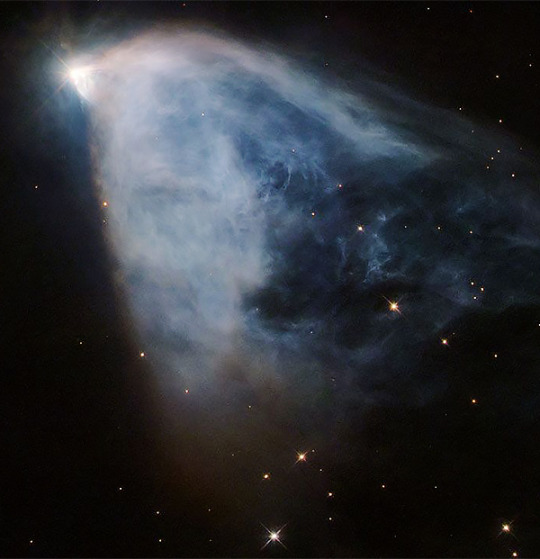#The Variable Nebula NGC 2261
Explore tagged Tumblr posts
Text

Hubble's Variable Nebula, C46 // Kent Wood
The bright star at the corner of the "fan" is R Monocerotis, a very young binary star system. Light from this star lights up the nearby cloud of gas and dust, but observations over just weeks shows that the nebula changes brightness. One explanation is that dense clouds of dust near R Monocerotis pass in front of it, periodically blocking light and casting a shadow on the nearby clouds.
#astronomy#astrophotography#caldwell catalog#nebula#reflection nebula#variable nebula#hubble's variable nebula#NGC 2261#caldwell 46#C46#monoceros
68 notes
·
View notes
Photo

2025 January 31
The Variable Nebula NGC 2261 Image Credit & Copyright: Tommy Lease (Denver Astronomical Society)
Explanation: The interstellar cloud of dust and gas captured in this sharp telescopic snapshot is seen to change its appearance noticeably over periods as short as a few weeks. Discovered over 200 years ago and cataloged as NGC 2261, bright star R Monocerotis lies at the tip of the fan-shaped nebula. About one light-year across and 2500 light-years away, NGC 2261 was studied early last century by astronomer Edwin Hubble and the mysterious cosmic cloud is now more famous as Hubble's Variable Nebula. So what makes Hubble's nebula vary? NGC 2261 is composed of a dusty reflection nebula fanning out from the star R Monocerotis. The leading variability explanation holds that dense knots of obscuring dust pass close to R Mon and cast moving shadows across the dust clouds in the rest of Hubble's Variable Nebula.
∞ Source: apod.nasa.gov/apod/ap250131.html
106 notes
·
View notes
Text

NGC 2264 & NGC 2261
( Christmas Tree Cluster and Hubble's Variable Nebula)
Distance: 2.500 ly
Monoceros constellation
February 25, 2023 -Montcada i Reixac-
#urban astrophotography#astro observations#astrophotos#astro community#astrophotography#cosmos#universe#original photographic works#original photography
19 notes
·
View notes
Text
Astronomy Picture of the Day
2025 January 31

The Variable Nebula NGC 2261
Image Credit & Copyright: Tommy Lease (Denver Astronomical Society)
The interstellar cloud of dust and gas captured in this sharp telescopic snapshot is seen to change its appearance noticeably over periods as short as a few weeks. Discovered over 200 years ago and cataloged as NGC 2261, bright star R Monocerotis lies at the tip of the fan-shaped nebula. About one light-year across and 2500 light-years away, NGC 2261 was studied early last century by astronomer Edwin Hubble and the mysterious cosmic cloud is now more famous as Hubble's Variable Nebula. So what makes Hubble's nebula vary? NGC 2261 is composed of a dusty reflection nebula fanning out from the star R Monocerotis. The leading variability explanation holds that dense knots of obscuring dust pass close to R Mon and cast moving shadows across the dust clouds in the rest of Hubble's Variable Nebula.
Authors & editors: Robert Nemiroff (MTU) & Jerry Bonnell (UMCP)
NASA Official: Amber Straughn
A service of: ASD at NASA / GSFC,
NASA Science Activation
& Michigan Tech. U.
0 notes
Text
The Variable Nebula NGC 2261
The interstellar cloud of dust and gas captured in this sharp telescopic snapshot is seen to change its appearance noticeably over periods as short as a few weeks. Discovered over 200 years ago and cataloged as NGC 2261, bright star R Monocerotis lies at the tip of the fan-shaped nebula. About one light-year across and 2500 light-years away, NGC 2261 was studied early last century by astronomer…
0 notes
Text
The Variable Nebula NGC 2261
The interstellar cloud of dust and gas captured in this sharp telescopic snapshot is seen to change its appearance noticeably over periods as short as a few weeks. Discovered over 200 years ago and cataloged as NGC 2261, bright star R Monocerotis lies at the tip of the fan-shaped nebula. About one light-year across and 2500 light-years away, NGC 2261 was studied early last century by astronomer…

View On WordPress
0 notes
Photo

NGC 2261 - Hubble's Variable Nebula
#NGC 2261#Hubble's Variable Nebula#nasa#stargazing#astrophoto#astrophotography#galaxy#astronomy#universe#space#nebula#spinningblueball#thespinningblueball#milky way#milky way galaxy#milkywaygalaxy#spacephotography#nightsky#starrynight#milkywayphotography#astrophotos#starscape#star#cosmos#telescope#hubble#chandra#spitzer#hubble telescope#chandra telescope
157 notes
·
View notes
Photo

Hubble’s Variable Nebula NGC 2261
2K notes
·
View notes
Photo

NGC 2261: Hubble's Variable Nebula
Photo by NASA/ESA's Hubble Space Telescope
136 notes
·
View notes
Text

Hubble's Variable Nebula, C46 // Haejong Kim
Hubble's Variable Nebula (NGC 2261) is cloud of gas and dust extending from a bright star like smoke rising from a newly lit fire. This reflection variable nebula lies about 2,500 light years away in the constellation of Monoceros, the Unicorn.
Although it was first discovered by William Herschel (1738-1822) in 1783, it was Edwin Hubble (1889-1953) who performed the first detailed analysis of this peculiar fan-shaped nebula.
#astronomy#astrophotography#caldwell catalog#nebula#reflection nebula#variable nebula#hubble's variable nebula#NGC 2261#caldwell 46#C46#monoceros
54 notes
·
View notes
Photo

NGC 2261, Hubble's Variable Nebula
#Astronomy#NASA#Night#Sky#Stars#Space#Science#Universe#Cosmos#Cosmic#Solar System#Constellations#Nebula#Galaxy#Hubble#Telescope#Rainbow#Bright
3K notes
·
View notes
Photo

NGC 2261: Hubble's Variable Nebula [1507 × 1490]
85 notes
·
View notes
Photo

2017 November 8
NGC 2261: Hubble's Variable Nebula Image Credit: Hubble, NASA, ESA; Data: Mark Clampin (NASA's GSFC); Processing & License: Judy Schmidt
Explanation: What causes Hubble's Variable Nebula to vary? The unusual nebula featured here changes its appearance noticeably in just a few weeks. Discovered over 200 years ago and subsequently cataloged as NGC 2661, the remarkable nebula is named for Edwin Hubble, who studied it early last century. Fitting, perhaps, the featured image was taken by another namesake of Hubble: the Space Telescope. Hubble's Variable Nebula is a reflection nebula made of gas and fine dust fanning out from the star R Monocerotis. The faint nebula is about one light-year across and lies about 2500 light-years away towards the constellation of the Unicorn (Monocerotis). The leading variability explanation for Hubble's Variable Nebula holds that dense knots of opaque dust pass close to R Mon and cast moving shadows onto the reflecting dust seen in the rest of the nebula.
∞ Source: apod.nasa.gov/apod/ap171108.html
17 notes
·
View notes


